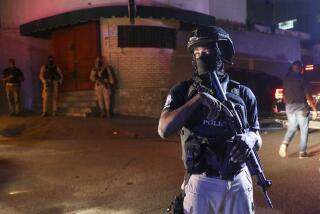The number of displaced rises rapidly
- Share via
WASHINGTON — Sectarian violence has driven 181,000 Baghdad residents from their homes in the last three months, and more than 1 million more could be forced to flee in the next six months if trends continue, an international relief group said Monday.
International Medical Corps, based in Santa Monica, said in a study that 546,078 Iraqis had been displaced since the February 2006 bombing of a Shiite Muslim shrine in Samarra intensified sectarian fighting.
Eighty percent of the departures have been in ethnically mixed Baghdad, the site of bitter fighting between Sunni Arab insurgents and Shiite Muslim militias.
The organization’s estimates of the toll are even higher than those issued by the United Nations and suggest that the pace of the departures is accelerating rapidly -- the number of those displaced has increased by 43% since November, according to the study.
The departures are reshaping the city along sectarian lines, much as Sarajevo was reshaped by ethnic fighting in Bosnia-Herzegovina in the early 1990s. Unlike displacements that occurred before the February bombing, the most recent moves appear to be permanent, the study says. Earlier movements often were forced by short-term military operations, but these departures often involve the sale or abandonment of property, the study notes.
The study is based on official statistics and interviews with Iraqi officials, tribal leaders and residents.
Nancy Aossey, International Medical Corps president and chief executive, said that although many of the displaced move in with friends and relatives in safer areas, many others have no shelter. Healthcare and food are in short supply because the population shifts have outstripped the capacity of the government and the limited international aid effort.
Aossey, whose group is one of the few nonprofit relief groups still working in Iraq, said the situation was a “brewing humanitarian crisis of enormous proportions.”
“Regardless of what one thinks of the war, it is a humanitarian crisis, and the world community should be concerned,” she said.
The study forecasts that in the coming months, about 350,000 “internally displaced persons” are likely to move to Baghdad neighborhoods dominated by members of their own sect. More than 200,000 Sunni residents of the city are likely to move to Sunni-majority governorates west, north and east of the capital; a slightly larger number of Shiite refugees are expected to leave the city for Shiite-dominated southern Iraq, the report says.
It says any forced return of the refugees “is likely to spur additional violence and a new wave of displacement.”
Before the sectarian fighting, the Tigris River was a rough ethnic dividing line for the city, with Shiite neighborhoods to the east and Sunni ones to the west. But as sectarian fighting has intensified, Shiite militias have taken more and more land west of the river.
Although the Pentagon is adding forces to Baghdad in hopes of halting attempts at “religious cleansing,” the report notes that only a few neighborhoods, such as Karada and Mansour, can be described as still mixed along sectarian lines.
The Office of the United Nations High Commissioner for Refugees estimates that about 1.7 million people are “internally displaced” in Iraq, and that the number could rise to 2.7 million by the end of this year.
It has said that about 12% of Iraqis -- about 3.2 million people -- have fled their homes at one point or another due to violence since the U.S.-led invasion in 2003. The displacements represent the largest long-term movement of people in the Middle East since the creation of Israel in 1948, according to the UNHCR.
The agency estimates that 500,000 to 1 million Iraqis have moved to Syria; up to 700,000 to Jordan; 80,000 to Egypt and 40,000 to Lebanon.
*
More to Read
Sign up for Essential California
The most important California stories and recommendations in your inbox every morning.
You may occasionally receive promotional content from the Los Angeles Times.











